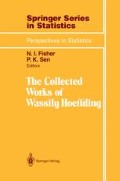Abstract
The problem of “optimum” tests has two aspects: (1) the choice of a definition of “optimum,” and (2) the mathematical problem of constructing the test. The second problem may be difficult, but at least it is definite once an “optimum” test has been defined. But the definition itself involves a considerable amount of arbitrariness. Clearly, the definition should be “reasonable” from the point of view of the statistician (which is a very vague requirement) and it should be realizable, that is, an “optimum” test must exist, at least under certain conditions (which is trivial). Furthermore, even a theoretically “best” test is of no use if it cannot be brought into a form suitable for applications. When deciding which of two tests is “better” one ought to take into account not only their power functions but also the labor required for carrying out the tests.
Access this chapter
Tax calculation will be finalised at checkout
Purchases are for personal use only
Preview
Unable to display preview. Download preview PDF.
References
W. Feller, “Note on regions similar to the sample space,” Stat. Res. Memoirs, Vol. 2 (1938), pp. 117–125.
R. A. Fisher and F. Yates, Statistical Tables for Biological, Agricultural and Medical Research, 3rd ed., Hafner, New York, 1949.
E. L. Lehmann, “Some principles of the theory of testing hypotheses,” Annals of Math. Stat., Vol. 21 (1950), pp. 1–26.
E. L. Lehmann and C. Stein, “On the theory of some nonparametric hypotheses,” Annals of Math. Stat., Vol. 20 (1949), pp. 28–45.
G. Noether, “On a theorem by Wald and Wolfowitz,” Annals of Math. Stat., Vol. 20 (1949), pp. 455–458.
E. J. G. Pitman, “Significance tests which may be applied to samples from any population,” Jour. Roy. Stat. Soc, Suppl., Vol. 4 (1937), pp. 119–130 and 225-232.
H. Scheffé, “On a measure problem arising in the theory of non-parametric tests,” Annals of Math. Stat., Vol. 14 (1943), pp. 227–233.
A. Wald, “Statistical decision functions,” Annals of Math. Stat., Vol. 20 (1949), pp. 165–205.
A. Wald and J. Wolfowitz, “Statistical tests based on permutations of the observations,” Annals of Math. Stat., Vol. 15 (1944), pp. 358–372.
Author information
Authors and Affiliations
Editor information
Editors and Affiliations
Rights and permissions
Copyright information
© 1994 Springer Science+Business Media New York
About this chapter
Cite this chapter
Hoeffding, W. (1994). “Optimum” Nonparametric Tests. In: Fisher, N.I., Sen, P.K. (eds) The Collected Works of Wassily Hoeffding. Springer Series in Statistics. Springer, New York, NY. https://doi.org/10.1007/978-1-4612-0865-5_11
Download citation
DOI: https://doi.org/10.1007/978-1-4612-0865-5_11
Publisher Name: Springer, New York, NY
Print ISBN: 978-1-4612-6926-7
Online ISBN: 978-1-4612-0865-5
eBook Packages: Springer Book Archive

